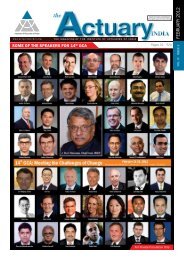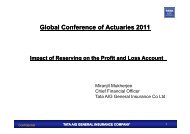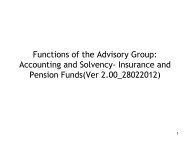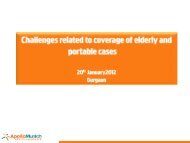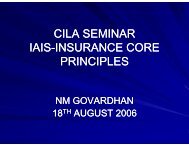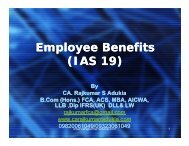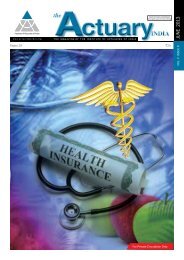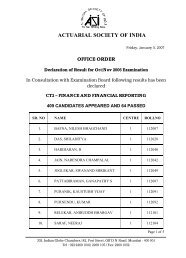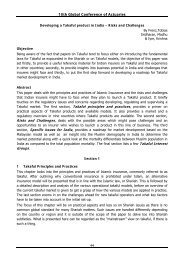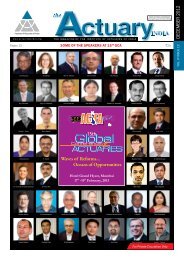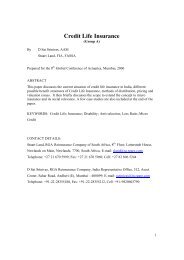January - Actuarial Society of India
January - Actuarial Society of India
January - Actuarial Society of India
Create successful ePaper yourself
Turn your PDF publications into a flip-book with our unique Google optimized e-Paper software.
FEATURES<br />
Unit Linked:<br />
While it must be clear by now that AoS<br />
exercise is sensitive to the order <strong>of</strong><br />
factors while “truing up because <strong>of</strong><br />
compound effects <strong>of</strong> various factors, this<br />
is especially so in unit linked business<br />
where the unit fund value affects<br />
ancillary cashows. For example,<br />
a ortality surplus v/s Investment<br />
surplus<br />
In products where death benet is<br />
higher <strong>of</strong> the fund value and a given<br />
sum assured, the mortality prot<br />
prole will change post application <strong>of</strong><br />
actual unit fund growth rates.<br />
b “Rebase surplus v/s Investment<br />
surplus<br />
Unless the models are rebasing the unit<br />
fund at every unit <strong>of</strong> time some surplus<br />
will start arising from second unit <strong>of</strong> time<br />
owing to different unit funds in valuation<br />
and projection calculations.<br />
In above and related cases the actuary<br />
must take a conscious call about<br />
attribution <strong>of</strong> surplus. It is important that<br />
whatever decision is taken is consistent<br />
with the understanding <strong>of</strong> the target<br />
audience <strong>of</strong> the AoS analysis and they<br />
have been apprised <strong>of</strong> such decisions<br />
appropriately.<br />
With Prots:<br />
The surplus due to increase in bonus<br />
liability should <strong>of</strong>fset by those sources<br />
<strong>of</strong> surplus which are being shared with<br />
the policy holders. Quantifying the<br />
bonus liability surplus and comparing<br />
it with surpluses being shared with<br />
policyholders is an additional level <strong>of</strong><br />
check on the bonuses being declared.<br />
AoS and the <strong>India</strong>n statute<br />
The Assets, Liability and Solvency argin<br />
Regulations (2000 require the liabilities<br />
to be oored at higher <strong>of</strong> surrender value<br />
or zero at a contract level. As a result,<br />
even if all actual experience were to be<br />
in line with the assumptions used for<br />
liability calculation some surplus may<br />
arise. Let us call this “Expected Valuation<br />
Surplus (EVS for the time being.<br />
For example, consider a hypothetical<br />
policy <strong>of</strong> one year where all future inows<br />
exceed outows by amount “c on<br />
reserving basis. The statutory reserve<br />
held towards this policy will be zero,<br />
not a negative number. So, even if all<br />
experience is as per reserving basis<br />
there will be a surplus <strong>of</strong> “c (this would<br />
have been zero if the reserve was a<br />
negative amount.<br />
Failure to recognize the role <strong>of</strong> EVS<br />
in generating a surplus may lead<br />
stakeholders to overestimate the<br />
nancial soundness <strong>of</strong> the company.<br />
It is therefore very important that this<br />
component <strong>of</strong> surplus is appropriately<br />
accounted for and explained to all<br />
stakeholders.<br />
Final words<br />
any <strong>India</strong>n insurers have started<br />
publicizing their statutory prots.<br />
These numbers are closely observed<br />
by many stakeholders in the economy.<br />
Statutory prot remains one <strong>of</strong> the<br />
most commonly used measures <strong>of</strong><br />
nancial performance. An AoS report<br />
is likely to aide in the understanding<br />
<strong>of</strong> stakeholders interested in statutory<br />
prots <strong>of</strong> the company.<br />
ANNOUNCEMENT FOR MEMBERS OF IAI<br />
The Actuary <strong>India</strong> Scheme <strong>of</strong> Awards for Best Article &<br />
Reportage for the Calendar year 2012 and thereafter till amended<br />
The objectives: recognition <strong>of</strong> the efforts put in and encourages members to write for the Actuary <strong>India</strong> magazine either in<br />
the form <strong>of</strong> Articles and/or reportage for various IAI events.<br />
Process <strong>of</strong> selection: Three member Selection Group will be appointed by the President in ec. 2012 and every ecember<br />
thereafter to set parameters for selection and recommend best two Articles and best two Reportages in order <strong>of</strong> merit.<br />
The Awards and recognition: Based on the Selection Group’s recommendations, the following rules shall apply;<br />
a The awards will be given by the Chief Editor during the AGFA held immediately after the end <strong>of</strong> the calendar year 2012.<br />
The awards will be in the form <strong>of</strong> cash prize and recognition plaque.<br />
b The three member selection Group will send its recommendation by <strong>January</strong> each year based on editions published in<br />
a calendar year 2012 and each Calendar year thereafter.. Every member <strong>of</strong> the selection Committee will come out with<br />
his/her own list <strong>of</strong> best ve articles/reportages. Thereafter, the Group will meet in the second week <strong>of</strong> <strong>January</strong> and come<br />
out with a commonly agreed upon best two. In the event there is no unanimity the Selection Group will decide on how to<br />
select the best two (e.g. going by majority view, draw <strong>of</strong> lots from the ve best drawn by each or any other. This list, along<br />
with justications, will be sent to the President well in time for him/her to announce.<br />
c The Author/s <strong>of</strong> rst best Article and Reportage will receive a prize <strong>of</strong> Rs. 10,000/- for the Article and the Reportage and<br />
the next best will receive Rs. 5,000/- accordingly. In case there are more than one Authors, the amount will be allocated<br />
equally, however the recognitions plaques will be given to each.<br />
d In order to qualify each article/reportage should meet the following minimum criteria;<br />
I. at least about 500 words.<br />
II. should not be reproduced from articles elsewhere (while sending the article the author should give a declaration to<br />
this effect.<br />
III. Should be written by a member <strong>of</strong> the IAI (in the case <strong>of</strong> joint authors, all should be members <strong>of</strong> the IAI at the time<br />
the article is published.<br />
IV. Reportage should be based on event organized by IAI only.<br />
e The award winning authors along with the Selections Groups key points on selection will be published in the March issue<br />
<strong>of</strong> the Actuary <strong>India</strong> each year.<br />
Liyaquat Khan<br />
24 The Actuary <strong>India</strong>



